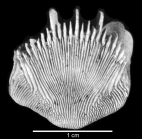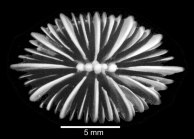WoRMS taxon details
Alatotrochus Cairns, 1994
267212 (urn:lsid:marinespecies.org:taxname:267212)
accepted
Genus
Platytrochus rubescens Moseley, 1876 accepted as Alatotrochus rubescens (Moseley, 1876) (type by original designation)
marine, fresh, terrestrial
recent + fossil
Cairns, S.D. (1994). Scleractinia of the temperate North Pacific. <em>Smithsonian Contributions to Zoology.</em> 557: 1-150. [details] Available for editors  [request]
[request]
Depth range 106-751 m
Fossil range Pleistocene to Recent
Depth range 106-751 m [details]
Fossil range Pleistocene to Recent
Fossil range Pleistocene to Recent [details]
Hoeksema, B. W.; Cairns, S. (2025). World List of Scleractinia. Alatotrochus Cairns, 1994. Accessed through: World Register of Marine Species at: https://www.marinespecies.org/aphia.php?p=taxdetails&id=267212 on 2025-05-04
Date
action
by
![]() The webpage text is licensed under a Creative Commons
Attribution 4.0 License
The webpage text is licensed under a Creative Commons
Attribution 4.0 License
Nomenclature
original description
Cairns, S.D. (1994). Scleractinia of the temperate North Pacific. <em>Smithsonian Contributions to Zoology.</em> 557: 1-150. [details] Available for editors  [request]
[request]
basis of record van der Land, J. (ed). (2008). UNESCO-IOC Register of Marine Organisms (URMO). , available online at http://www.marinespecies.org/urmo/ [details]
basis of record van der Land, J. (ed). (2008). UNESCO-IOC Register of Marine Organisms (URMO). , available online at http://www.marinespecies.org/urmo/ [details]
Taxonomy
redescription
Cairns, S.D. (1995). The marine fauna of New Zealand: Scleractinia (Cnidaria: Anthozoa. <em>New Zealand Oceanographic Memoir.</em> 103: 1-210. [details] Available for editors  [request]
[request]
redescription Cairns, S.D. (1997). A generic revision and phylogenetic analysis of the Turbinoliidae (Cnidaria: Scleractinia). <em>Smithsonian Contributions to Zoology.</em> 591: 1-55. [details] Available for editors [request]
[request]
redescription Cairns, S.D. (1997). A generic revision and phylogenetic analysis of the Turbinoliidae (Cnidaria: Scleractinia). <em>Smithsonian Contributions to Zoology.</em> 591: 1-55. [details] Available for editors
Other
context source (Hexacorallia)
Fautin, Daphne G. (2013). Hexacorallians of the World. (look up in IMIS) [details]
additional source Cairns, S.D., R. Baron-Szabo, A.F. Budd, B. Lathuilière, E. Roniewicz, J. Stolarski & K.G. Johnson. (2010). Corallosphere. , available online at http://www.corallosphere.org [details]
additional source Tachikawa, H. (2011). Review of the Japanese species of Alatotrochus and Sphenotrochus (Cnidaria : Anthozoa : Scleractinia : Turbinoliidae), with description of a new species, A. japonicus. <em>Memoirs of the National Museum of Nature and Science.</em> 47: 39-50. [details]
additional source Cairns, S.D., R. Baron-Szabo, A.F. Budd, B. Lathuilière, E. Roniewicz, J. Stolarski & K.G. Johnson. (2010). Corallosphere. , available online at http://www.corallosphere.org [details]
additional source Tachikawa, H. (2011). Review of the Japanese species of Alatotrochus and Sphenotrochus (Cnidaria : Anthozoa : Scleractinia : Turbinoliidae), with description of a new species, A. japonicus. <em>Memoirs of the National Museum of Nature and Science.</em> 47: 39-50. [details]
 Present
Present  Inaccurate
Inaccurate  Introduced: alien
Introduced: alien  Containing type locality
Containing type locality
From editor or global species database
Comparison Differs from <i>Pleotrochus</i> in having edge crests and lacking pali. [details]Diagnosis Corallum cuneiform, with rounded base and transversely ridged, alate edge crests; relatively large (up to 20 mm in GCD); theca imperforate; costae granular, independent in origin, numbering twice that of septa; four cycles of seta; pali absent; columella linear-papillose. [details]
Remark This genus and family was monographed by Cairns (1997), which includes a phylogenetic analysis based on morphology. [details]
Unreviewed
Biology azooxanthellate [details]Depth range 106-751 m [details]
Fossil range Pleistocene to Recent [details]










